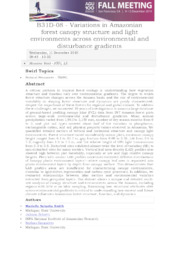Variations in Amazonian forest canopy structure and light environments across environmental and disturbance gradients.
Variations in Amazonian forest canopy structure and light environments across environmental and disturbance gradients.
Autoria: SMITH, M. N.; SCHITTI, J.; GONÇALVES, N.; MINOR, D.; ALMEIDA, D. R. A. de; ROCHA, D. G.; ARAGÓN, S.; MENIN, M.; GUEDES, M. C.; TONINI, H.; SILVA, K. E. da; ROSA, D. M.; NELSON, B. W.; CORDEIRO, C. L. O.; OLIVEIRA JUNIOR, R. C. de; SHAO, G.; SOUZA, M. S.; MCMAHON, S.; ALMEIDA, D.; ARAGÃO, L. E. O. C.; LIMA, N. Z. de; OLIVEIRA, G. de; ASSIS, R. L. de; CAMARGO, J. L.; MESQUITA, R. G.; SALESKA, S. R.; BRESHEARS, D. D.; COSTA, F. R. C.; STARK, S. C.
Resumo: A critical problem in tropical forest ecology is understanding how vegetation structure and function vary over environmental gradients. The degree to which forest structure changes across the Amazon basin and the role of environmental variability in shaping forest structure and dynamics are poorly characterised, despite the importance of these forests for regional and global climate. To address these challenges, we connected 10 years of investigations to amass a large database of ground-based profiling canopy lidar (PCL) data from 297 Amazon forest plots across large-scale environmental and disturbance gradients. Mean annual precipitation varied from 1,963 to 3,159 mm, number of dry season months from 0 to 5, and plot soil types covered about half of the variation in phosphorus, exchangeable cation, and soil physical property values observed in Amazonia. We quantified detailed metrics of vertical and horizontal structure and canopy light environments. Forest structure varied considerably across plots; maximum canopy height ranged from 6.1 to 35.7 m, gap fraction from 0.00 to 0.36, LAI from 0.5 to 7.3, rugosity from 1.5 to 7.5 m, and the relative height of 50% light transmission from 0.3 to 0.8. Disturbed sites exhibited almost twice the level of variation (SD) to non-disturbed sites for many metrics. Vertical leaf area density (LAD) profiles also showed high between plot variability, especially at low and high relative canopy heights. Plots with similar LAD profiles sometimes exhibited different distributions of ?canopy photic environment layers??where canopy leaf area is separated into photic environment layers by depth from canopy surface. This demonstrates that LAD profiles alone are insufficient for characterising canopy environments, essential to light-driven regeneration and carbon cycle processes. In addition, we evaluated relationships between lidar metrics and environmental variables extracted from geospatial layers. Our dataset allows a unique and detailed multi-site analysis of canopy structure and environments across the Amazon, including regions with little or no lidar sampling. Examining how structural attributes alter across environmental gradients is critical to understanding how current and future climate influences Amazonian forest structure, function, and dynamics.
Ano de publicação: 2019
Tipo de publicação: Resumo em anais e proceedings
Unidade: Embrapa Amapa
Palavras-chave: Climatologia, Ecologia Florestal, Floresta Tropical
Observações
1 - Por padrão são exibidas publicações dos últimos 20 anos. Para encontrar publicações mais antigas, configure o filtro ano de publicação, colocando o ano a partir do qual você deseja encontrar publicações. O filtro está na coluna da esquerda na busca acima.
2 - Para ler algumas publicações da Embrapa (apenas as que estão em formato ePub), é necessário ter, no celular ou computador, um desses softwares gratuitos. Sistemas Android: Google Play Livros; IOS: iBooks; Windows e Linux: software Calibre.
Acesse outras publicações
Acesse a Base de Dados da Pesquisa Agropecuária (BDPA) para consultar o acervo completo das bibliotecas da Embrapa.

